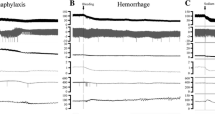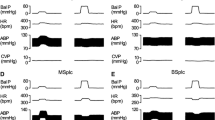Abstract
The present study was undertaken in anaesthetized pigs to determine whether distension of the stomach reflexly affects coronary blood flow. Experiments were performed on 17 pigs anaesthetized with ketamine and sodium pentobarbitone and artificially ventilated. Coronary blood flow was measured with an electromagnetic flowmeter positioned around the origin of the left circumflex coronary artery. The stomach was distended by injecting 0.81 warm Ringer solution into a balloon positioned within the stomach (mean gastric transmural pressure of about 13 mm Hg). Changes in aortic blood pressure and heart rate were prevented by a pressurized reservoir connected to the left femoral artery and by atrial pacing respectively. Distension of the stomach always caused a decrease in mean coronary blood flow. In five pigs, the magnitude of the decrease in coronary blood flow was graded by step increments in the gastric distending volume from 0.6 l to 1 l. The response of coronary blood flow was not affected by the administration of atropine (12 pigs), while it was abolished by the administration of bretylium tosylate (eight pigs) and by bilateral vagotomy (eight pigs; four cervical, four subdiaphragmatic vagotomy). These results show that innocuous distension of the stomach in anaesthetized pigs reflexly decreases coronary blood flow. This reflex response is mediated by sympathetic effects and its afferent limb involves the vagal nerves.
Similar content being viewed by others
References
Cevese A, Drinkhill M, Mary DASG, Patel P, Schena, F, Vacca G (1991) The effect of distension of the urinary bladder on coronary blood flow in anaesthetized dogs. Exp Physiol 76:409–421
Cevese A, Mary DASG, Poltronieri R, Schena F, Vacca G (1992) Efferent limb of the coronary vasoconstrictor reflex elicited by distension of the descending colon in anaesthetized dogs. Cardioscience 3:35–40
Cotterel DF, Iggo A (1984) Tension receptors with vagal afferent fibres in the proximal duodenum and pyloric sphincter of sheep. J Physiol (Lond) 354:457–475
Cowley AJ, Fullwood LJ, Stainer K, Harrison E, Muller AF, Hampton JR (1991) Postprandial worsening of angina. All due to change in cardiac output? Br Heart J 66:147–150
Falempin M, Mei N, Rousseau JP (1978) Vagal mechanoreceptors of the inferior thoracic oesophagus, the lower oesophageal sphincter and the stomach in sheep. Pflügers Arch 373:25–30
Feigl EO (1983) Coronary physiology. Physiol Rev 63:1–203
Furnival CM, Linden RJ, Snow HM (1970) Inotropic changes in the left ventricle: the effect of changes in heart rate, aortic pressure and end-diastolic pressure. J Physiol (Lond) 211:359–387
Gilbert NC, LeRoy GY, Fenn GK (1940) The effect of distension of abdominal viscera on the blood flow in the circumflex branch of the left coronary artery in the dog. Am Heart J 20:519–524
Goldstein RE, Redwood DR, Rosing DR, Beiser GD, Epstein SE (1971) Alterations in the circulatory response to exercise following a meal and their relationship to post-prandial angina pectoris. Circulation 44:90–100
Grollman A (1929) Physiological variations in the cardiac output in man. III. The effect of the ingestion of food on the cardiac output, pulse rate, blood pressure, and oxygen consumption of man. Am J Physiol 89:366–370
Grundy D, Davison JS (1981) Cardiovascular Changes elicited by vagal gastric afferents in the rat. Q J Exp Physiol 66:307–310
Grundy D, Scratcherd T (1989) Sensory afferents from the gastrointestinal tract. In: Schultz SG, Wood JD, Bauner BB (eds) Handbook of physiology, section 6. The gastrointestinal system. American Physiological Society, Bethesda, pp 593–620
Heusch G (1990) α-adrenergic mechanisms in myocardial ischemia. Circulation 81:1–13
Iggo A (1955) Tension receptors in the stomach and urinary bladder. J Physiol (Lond) 128:593–607
Irving JT, McSwiney BA, Suffolk SE (1937) Afferent fibres from the stomach and small intestine. J Physiol (Lond) 89:407–420
Janig W, Morrison JFB (1986) Functional properties of spinal visceral afferents supplying abdominal and pelvic organs, with special emphasis on visceral nociception. In: Cervero F, Morrison JFB (eds) Progress in brain research. Elsevier, Oxford, pp 87–114
Kelbaek H, Munck O, Christensen NJ, Godtfredsen J (1989) Central haemodynamic changes after a meal. Br Heart J 61:506–509
Kidd C, Li JM, McWilliam PN (1984) Cardiovascular reflexes elicited by gastric distension in the rat (abstract). J Physiol (Lond) 354:98P
Linden RJ, Mary DASG (1983) The preparation and maintenance of anaesthetized animals for the study of cardiovascular function. In: Linden RJ (ed) Techniques in the life sciences, cardiovascular physiology. Elsevier, County Clare, pp 1–22
Longhurst JC, Ibarra J (1982) Sympathoadrenal mechanisms in hemodynamic responses to gastric distension in cats. Am J Physiol 243:H748-H753
Longhurst JC, Ibarra J (1984) Reflex regional vascular responses during passive gastric distension in cats. Am J Physiol 247:R257-R265
Longhurst JC, Spilker HL, Ordway GA (1981) Cardiovascular reflexes elicited by passive gastric distension in anaesthetized cats. Am J Physiol 240:H539-H545
Paintal AS (1954) A study of gastric stretch receptors. The role in the peripheral mechanism of satiation of hunger and thirst. J Physiol (Lond) 126:255–270
Randich A, Gebhart GF (1992) Vagal afferent modulation of nociception. Brain Res 17:77–99
Schultz R, Oudiz RJ, Guth BD, Eusch G (1990) Minimal α 1 and α 2 adrenoceptor-mediated coronary vasoconstriction in the anaesthetized swine. Naunyn Schmiedebergs Arch Pharmacol 342:422–428
Vacca G, Vono P (1993) The primary reflex effects of distension of the stomach on heart rate, arterial pressure and left ventricular contractility in the anaesthetized pig. Pflügers Arch 425:248–255
Vacca G, Cevese A, Poltronieri R, Schena F (1991) Reflex effects of descending colon distension on coronary blood flow in anesthetized dogs. Cardioscience 2:123–129
Vacca G, Mary Dasg, Vono P (1993) Gastric distension reflexly decreases coronary blood flow in the anaesthetized pig (abstract). J Physiol (Lond) 467:232P
Vacca G, Vono P, Chiorboli E, Grossini E, Papillo B, Mary DASG (1993) Mechanisms of the reflex coronary vasoconstriction caused by stomach distension in the anaesthetized pig (abstract). Proc Int Union Physiol Sci, XXXII Congress abstracts, p 86, 173.66/P
Author information
Authors and Affiliations
Rights and permissions
About this article
Cite this article
Vacca, G., Mary, D.A.S.G. & Vono, P. The effect of distension of the stomach on coronary blood flow in anaesthetized pigs. Pflügers Arch 428, 127–133 (1994). https://doi.org/10.1007/BF00374849
Received:
Revised:
Accepted:
Issue Date:
DOI: https://doi.org/10.1007/BF00374849




